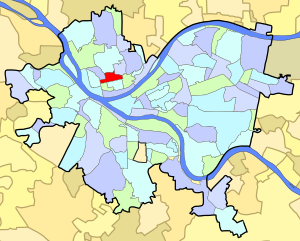Central Northside is a neighborhood in the North Side of the city of Pittsburgh, Pennsylvania. It has a zip code of 15212, and has representation on Pittsburgh City Council by the council member for District 6 (Downtown/Northshore Neighborhoods). Originally known as "The Buena Vista Tract", it is densely filled with restored row houses, community gardens and tree lined streets and alleyways.
Central Northside | |
|---|---|
 | |
 | |
| Coordinates: 40°27′22″N 80°00′36″W / 40.456°N 80.010°W | |
| Country | United States |
| State | Pennsylvania |
| County | Allegheny County |
| City | Pittsburgh |
| Area | |
| • Total | 0.259 sq mi (0.67 km2) |
| Population (2010)[1] | |
| • Total | 2,923 |
| • Density | 11,000/sq mi (4,400/km2) |
History
editIn the late 19th century, Allegheny, Pennsylvania (later annexed by Pittsburgh) became known for its stately homes, occupied by some of the area's wealthy families. One such area became known as the Mexican War Streets.
Mexican War Streets
editThe Mexican War Streets were laid out in 1847, during the Mexican–American War, by William Robinson Jr., ex-mayor of the city of Allegheny. Robinson, who contrary to some tellings did not actually serve in the war, subdivided his land and named the new streets after the war's battles and generals (Buena Vista Street, Filson Way, Monterey Street, Palo Alto Street, Resaca Place, Sherman Avenue, Taylor Avenue).[2]
City Steps
editThe Central Northside neighborhood has 4 distinct flights of city steps. In Central Northside, the Steps of Pittsburgh quickly connect pedestrians to public transportation and neighborhood schools.[3]
Surrounding Pittsburgh neighborhoods
editCentral Northside has seven city neighborhood borders with Perry South to the north, Fineview to the northeast, East Allegheny to the southeast, Allegheny Center to the south, Allegheny West to the southwest, Manchester to the west and California-Kirkbride to the northwest.
Fictional Portrayals
edit- The 1979 sports/cult classic The Fish That Saved Pittsburgh used the neighborhoods southern border of North Avenue's gritty former "burlesque row" adjacent to the Garden Theater to depict Stockard Channing's gypsy fortune teller characters office and residence.
- Thirty years later, in 2010, the Katherine Heigl film One for the Money[4] uses the same exact buildings complete with Garden Theater marquee to once again depict a gritty inner city environment—though much of the characters and vice of the North Avenue corridor has been corrected, the structures still adapt well on the areas southern border.
Gallery
edit-
Randyland Art Museum at 1501 Arch Street.
-
Engine Company No. 3, built in 1877, at 1416 Arch Street.
-
Ferris House (the former home of George Washington Gale Ferris Jr.), likely built in the mid-to-late 19th century, at 1318 Arch Street.
-
House at 200 West North Avenue, built circa 1880.
-
Aberlie House, likely built in the late 19th century, at 122-124 East North Avenue.
-
Allegheny City Stables, built in 1895 and 1896, at 836 West North Avenue.
-
Brown Chapel A.M.E. Church, built in 1903, at 1400 Boyle Street.
-
Garden Theater, built in 1915, at 12 West North Avenue.
-
Malta Temple (Salvation Army Building), built in 1927, at 100 West North Avenue.
-
Allegheny General Hospital, built from 1928 to 1930.
-
The Mattress Factory art museum at 500 Sampsonia Way.
-
The Mattress Factory's annex gallery building at 1414 Monterey Street (at the corner of Monterey and Jacksonia streets).
-
View of the neighborhood from the Fineview Overlook.
Name
editOn 10 September 2012, the Central Northside Neighborhood Council (CNNC) voted to change the neighborhood's name to Allegheny City Central.[5][6] However, according to an FAQ published by the CNNC in August 2012, the Council reported that official city maps would "probably not" reflect the name change and that the city planning department is "always very reluctant" to alter established names. The same document refers to the name change as a "branding initiative" which is part of a "new brand and marketing strategy".[7]
See also
editReferences
edit- ^ a b "PGHSNAP 2010 Raw Census Data by Neighborhood". Pittsburgh Department of City Planning [PGHSNAP Utility]. 2012. Retrieved 21 June 2013.
- ^ Rooney, Dan; Peterson, Carol (2013). Allegheny City: A History of Pittsburgh's North Side. University of Pittsburgh Press. pp. 32–33. ISBN 978-0-8229-4422-5.
- ^ Regan, Bob (2015). Pittsburgh Steps, The Story of the City's Public Stairways. Globe Pequot. ISBN 978-1-4930-1384-5.
- ^ North Side theater is X-rated — for Hollywood Archived 2011-01-17 at the Wayback Machine, by Bill Vidonic, Pittsburgh Tribune-Review. 2010-07-16. Retrieved 2010-08-11.
- ^ Walsh, Katie (13 September 2012). "New name, same place: Central Northside adopts new name for itself, now Allegheny City Central". The Duquesne Duke. Archived from the original on 4 March 2016. Retrieved 25 September 2012.
- ^ "Central Northside Neighborhood Council 10 September 2012 General Membership Meeting Minutes" (PDF). Allegheny City Central. Retrieved 19 December 2014.
- ^ "CNNC Branding Initiative Frequently Asked Questions" (PDF). Central Northside Neighborhood Council. August 2012. Retrieved 25 September 2012.